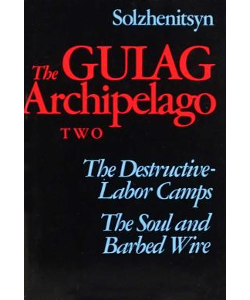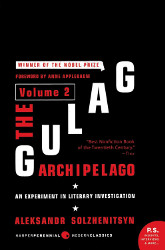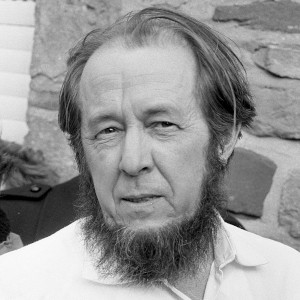The Gulag Archipelago: 1918-1956 (Volume 2)

Author:
Aleksandr I. Solzhenitsyn
Original language:
Russian
Translator:
Thomas P. Whitney
Publication:
1975 by Harper & Row Publishers, Inc
Genre:
History, Memoir, Non-fiction
Series:
The Gulag Archipelago Trilogy ![]() Members Only
Members Only
Series Number: 2
Pages:
712
Current state:
This book has been evaluated and information added. It has not been read and content considerations may not be complete.
Book Guide
What more can be said about the dread apparatus of Soviet repression than was said in the first volume of The Gulag Archipelago? There is, in truth, much, much more. Gulag One involved us in the innocent victim's arrest and preliminary detention and the stages by which he is transferred across the breadth of the Soviet Union to his ultimate destination: the hard-labor camp. It was at the threshold of camp that Gulag One left us, and it is the experience of camp that constitutes the substance of Gulag Two.
Camps for hard labor were not a Soviet invention, but in Tsarist times their function was simply punitive. Only under the Soviets—and especially under Stalin—were the camps (christened "Constructive Labor Camps") assigned a crucial role in the economy of the whole state. The first four-fifths of this new volume cover what the author calls the "Destructive-Labor Camps" and the fate of prisoners in them, felling lumber, building canals and railroads, mining gold, without equipment or adequate food or clothing, and subject always to the caprices of the camp authorities. Most tragic of all is the life of the women prisoners . . . and of the luckless children they bear.
Once again, this chronicle of appalling inhumanity is made endurable by the vitality and emotional range of the writing. In one truly remarkable chapter—a parody of an anthropological treatise, in which the author describes the "sons of Gulag," their language and "culture" as thought they constituted an exotic, newly discovered tribe—he achieves new heights of sardonic wit. And in the final section, "The Soul and Barbed Wire," the music changes and he provides a magnificent coda on the possibilities of redemption and purification through suffering.
Previewing this new volume, Time magazine wrote: "Gulag Two may well be Solzhenitsyn's most stunning achievement to date."
From the dust jacket
To view an example page please sign in.
Please sign in to access the type of illustrations and view more books with this type.
Please sign in for audiobook information.

![]()
The Gulag Archipelago: Volume 2 ![]()
Reprinted in 2007 by Harper Perennial
Available formats: Paperback
View on Amazon
View on Bookshop.org
View Ebook on Amazon
View Audiobook on Amazon

![]()
The Gulag Archipelago: Abridged (Authorized by Author) ![]() Abridged
Abridged
Reprinted in 2007 by Harper Perennial
Available formats: Paperback
View on Amazon
View on Bookshop.org
View Ebook on Amazon
View Audiobook on Amazon
The official, one-volume edition, authorized by Solzhenitsyn.
Please sign in for additional information about this book.
Content Guide
Please sign in to access all of the topics associated with this book and view other books with the same topics.
Please sign in to access the time periods this book takes place in and view other books in the same time period.
For information about the lead characters please sign in.
Please sign in to discover interesting content included in the illustrations of this book.



